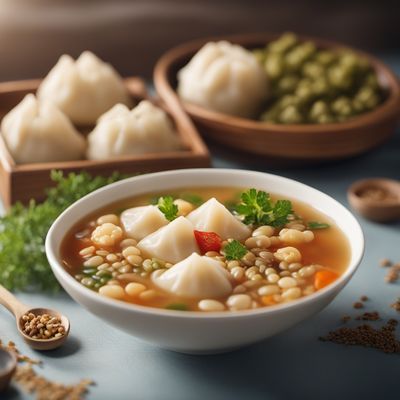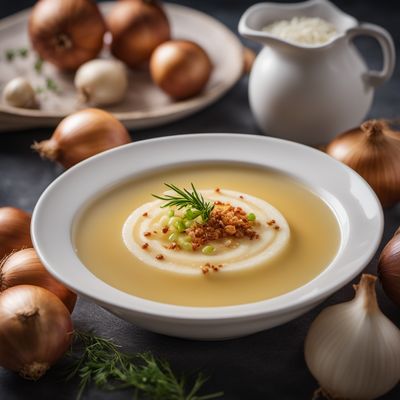
Ingredient
Fruit soup
Refreshing Medley: Exploring the World of Fruit Soup
Fruit soup is a vibrant and colorful dish made by combining a medley of fresh fruits, such as berries, melons, and citrus, with a sweetened liquid base, often made from fruit juice or syrup. The fruits are typically diced or sliced and then mixed with the liquid, allowing the flavors to meld together. The resulting soup is served chilled and can be garnished with fresh herbs or a dollop of yogurt for added creaminess. The texture of fruit soup can vary depending on the fruits used, ranging from chunky to smooth, and it offers a delightful contrast between the juicy fruits and the light, refreshing broth.
Origins and history
Fruit soup has a long history and is enjoyed in various cultures around the world. It is believed to have originated in Scandinavia, where it was traditionally served as a summer dish to cool down during hot weather. Fruit soup has also been a popular dish in Eastern European countries like Poland and Hungary, where it is often served as a dessert. In these regions, fruit soup is commonly made with local fruits and is enjoyed during festive occasions or as a refreshing treat on warm days. Over time, fruit soup has gained popularity in other parts of the world, with variations and adaptations to suit different culinary preferences.
Nutritional information
Fruit soup is a nutritious dish that provides a range of vitamins, minerals, and antioxidants. It is low in calories and fat, making it a healthy option for those watching their weight. The fruits used in fruit soup are rich in fiber, which aids digestion and promotes satiety. Additionally, fruit soup is a great source of hydration, especially during hot weather, as it contains a high water content from the fruits and the liquid base.
How to select
When selecting fruits for fruit soup, choose ripe and seasonal varieties that are firm, fragrant, and free from bruises or blemishes. Opt for fruits that are naturally sweet and flavorful to enhance the taste of the soup. It is also important to consider the texture of the fruits, ensuring they are not overly soft or mushy, as they may disintegrate when mixed with the liquid. If possible, select organic or locally sourced fruits to support sustainable farming practices and enjoy the freshest flavors.
Storage recommendations
To store fruit soup, transfer it to an airtight container and refrigerate for up to 3 days. Make sure the container is tightly sealed to prevent any odors from permeating the soup. Before serving, give the soup a gentle stir to redistribute the fruits and flavors. If the soup has become too thick, you can add a splash of fruit juice or water to adjust the consistency. Avoid freezing fruit soup, as the texture and quality of the fruits may be compromised upon thawing.
Preparation tips
Fruit soup can be enjoyed as is, served chilled in a bowl or glass. It can be garnished with fresh mint leaves, a sprinkle of cinnamon, or a dollop of yogurt for added creaminess. Fruit soup can also be used as a topping for pancakes, waffles, or ice cream, adding a burst of fruity flavors to these dishes. For a more elegant presentation, fruit soup can be served in hollowed-out fruit shells, such as watermelon or pineapple, creating a stunning centerpiece for special occasions.
Culinary uses
Fruit soup is commonly enjoyed as a refreshing summer dish in Scandinavian countries like Sweden and Finland. It is also popular in Eastern European cuisines, particularly in Poland and Hungary, where it is often served as a dessert during festive occasions. Fruit soup can be found in various forms and adaptations in different parts of the world, including the United States, where it is embraced as a light and healthy option for warm weather.
More ingredients from this category » Browse all

Gazpacho and similar
Refreshing Cold Soups: Gazpacho and Similar

Corn semolina based thick soup
Golden Corn Delight Soup

Tomato soup
The Comforting Elixir: Tomato Soup

Cereal products and grains based soup
Hearty Grains Delight

Dairy/egg soup
Creamy Delight Soup

Onion soup
"Savory Delight: Unveiling the Aromas of French Onion Soup"

Legume (beans) soup
Hearty and Nourishing Legume Soup

Potato soup
Creamy Comfort: Exploring the Delights of Potato Soup

Mushroom soup
Savory Elixir: Unveiling the Magic of Mushroom Soup

Mixed soups
A Symphony of Flavors: Exploring the World of Mixed Soups

Fish soup
A Taste of the Sea in a Bowl

Meat soup
Savory Delight: Exploring the World of Meat Soup